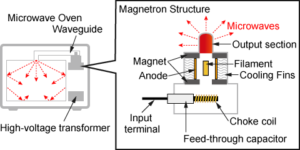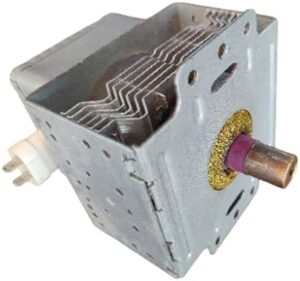Introduction of Microwave Magnetron

In the realm of modern kitchen appliances, the microwave oven stands as a symbol of convenience and efficiency. At the core of this ingenious device lies a remarkable component known as the magnetron. This microwave magnetron is powerful device and responsible for transforming our culinary landscape, revolutionizing the way we cook and heat food. In this exploration, we delve into the intricacies of the microwave magnetron, uncovering its functionality, historical significance, and its impact on contemporary cooking.
The Genesis of the Microwave Magnetron:
The journey of the microwave magnetron began in the early 20th century when scientists were investigating the properties of microwaves. In 1921, Albert Hull patented the concept of the cavity magnetron, a device capable of producing high-frequency electromagnetic waves, including microwaves. However, it wasn’t until World War II that the magnetron found its practical application.
During the war, radar systems played a crucial role in military operations, and the cavity magnetron became instrumental in the development of radar technology. The magnetron’s ability to generate microwave signals with high power and frequency made it an invaluable tool for detecting enemy aircraft. This wartime innovation laid the groundwork for the magnetron’s transition into civilian life, particularly in the realm of consumer appliances.
The Anatomy of a Microwave Magnetron:
A microwave magnetron is a vacuum tube that converts electrical energy into electromagnetic waves, specifically microwaves. Its core components include a cathode, an anode, a resonant cavity, and a magnetic field. The cathode emits electrons, which are then accelerated towards the anode by an electric field. As these electrons move through the resonant cavity, a magnetic field perpendicular to their motion causes them to spiral.
This spiral motion of electrons generates high-frequency microwaves, typically around 2.45 gigahertz for household microwaves. The resonant cavity, shaped like a donut, helps in concentrating and directing these microwaves toward the food being heated. The result is efficient and uniform cooking, as the microwaves excite water molecules in the food, generating heat through a process known as dielectric heating.
How a microwave magnetron works:
Electron Gun: The magnetron begins with an electron gun, which emits a stream of electrons. This electron stream is generated by heating a cathode, causing it to release electrons.
Magnetic Field: The emitted electrons then pass through a strong magnetic field. This field is usually created by magnets surrounding the cathode. The magnetic field causes the electrons to move in circular or helical paths.
Resonant Cavity: The electrons move into a resonant cavity, which is a hollow space with walls made of a conductive material (usually copper). The cavity is designed to allow the electrons to interact with the electric and magnetic fields in a way that promotes the generation of microwaves.
Microwave Generation: As the electrons move through the resonant cavity, they experience forces that cause them to bunch together periodically. This bunching of electrons leads to the emission of microwave radiation. The frequency of the microwaves is determined by the design of the cavity and the strength of the magnetic field.
Output Waveguide: The microwaves generated inside the resonant cavity are then directed out of the magnetron through a waveguide. This waveguide delivers the microwaves to the cooking chamber of the microwave oven.
Cooking Process: In the cooking chamber, the microwaves interact with the water molecules present in the food. The microwaves cause the water molecules to absorb energy and heat up, which, in turn, cooks the food.
The efficiency and reliability of a microwave oven depend significantly on the proper functioning of the magnetron. If the magnetron fails, the oven will be unable to generate microwaves, rendering it ineffective for cooking.

